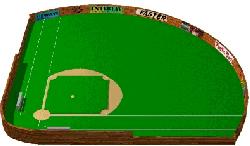|
|
|
How To Layout A Baseball Field
Reprinted From:
Beacon Ballfields

- The first matter to consider when laying out a
ball field
is the
sun angle. How will the sun impact the ballplayers at the time of day
when most games will take place on the field? This is a very important
consideration because it can affect every player on the diamond –
batters and fielders
Ideally, you should try to keep the sun out of the batter’s line of
sight. It is very difficult, not to mention dangerous, for a batter
to try to pick up a pitch when looking either directly or indirectly
into the sun. In other words, it is best to keep the sun entirely
behind the batter’s head so it does not present a problem during play.
It is also very important to try to impact the least amount of fielders
with the sun angle as well. Generally speaking, the best angle for
both batters and fielders is to have the centerline of the field run
from southwest to northeast with home plate in the southwestern end.
The centerline of the field is the imaginary line running from the
apex of home plate, through the middle of second base, and on to
centerfield.
Now that you have an idea of the direction the field should face,
choose where you want home plate to be located. Check with your ruling
jurisdiction for the proper distance between home plate and the
backstop. If there is already a backstop installed in the field, make
sure that you center the home plate with the backstop. The objective
is to have the centerline of the field be a continuation of the
centerline that runs from the existing backstop to home plate. Place
a pin, stake or marking flag where you want the point of home plate
to be located.
Next, using a 200 ft. (or longer) measuring tape with one end
attached to the stake at home plate, measure out in a direction that
you want to locate second base. Place another stake at the proper
distance for the base, according to the ruling league or jurisdiction
that you are in. This point should be the exact center of second base
and should fall on the centerline of the field.
To find the location for first base, extend the measuring tape
from second base in the direction of where the approximate location of
first base will be. Be sure to measure the required distance according
to your league of play. Then, extend a second measuring tape from the
home plate towards the stake towards first base. The point at which
these two tapes intersect with equal distances from home plate to first
base and first base to second base is where you will place another
stake. This point will be the back outside corner of first base.
Repeat this process again to find the location of third base.
To double check your work, and make sure the diamond is perfectly
square, measure the diagonals of the square that you have just created.
The distance measured from the back outside corner of first to the back
outside corner of third should be the same as the measurement from the
apex of home plate to the exact center of second base.
The next step after locating home plate and the three bases is to
locate the pitching mound. The center of the mound is again located on
the centerline of the field at a set distance from home plate that is
dictated by the rules of the league that uses the field. This distance
is always measured from the apex of the white portion of home plate
towards second base. The black outside edging on the plate is not
actually part of the plate and is not included when measuring.
Finally, locate where the foul poles and the outfield foul lines
should be located, it is best to use the geometric formula for a right
angle (A2+B2=C2). To find the left field foul line, let A equal the
distance between second and third base. Let B equal the distance you
want the foul line to extend past third base to the foul pole. Square
each of these two numbers. Add them together. The take the square root
of the sum of the two numbers to come up with the length C, or the
hypotenuse. Once you have A, B, and C, you can then go to work in the
field triangulating the location of your foul pole.
Place a stake at the back corner of third base. Place another stake in
the exact center of second base (if you have been following this guide,
these stakes should already be set). Extend a 300’ measuring tape from
each of the stakes towards the left field foul pole. The tape that is
running from the third base stake should be extended out to the distance
of B in the above calculation. The other tape should be extended out
from second base to the distance C. This distance, known as the
hypotenuse, is the longest side of the right triangle that you formed
between second base, third base, and the left field foul pole.
Pull the two measuring tapes towards each other until they intersect
at the appropriate distances, B and C. Place a stake or marker of some
type at this location to mark the left field corner. Repeat this
process using first base, second base, and the right field corner to
locate the right field foul pole.
|
|